FluWatch report: February 25 to March 3, 2018 (week 9)
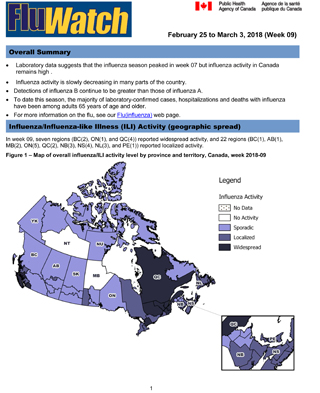
Download the alternative format
(PDF format, 539 KB, 10 pages)
Organization:
Public Health Agency of Canada
Date published: 2018-03-09
Related Topics
Overall Summary
- Laboratory data suggests that the influenza season peaked in week 07 but influenza activity in Canada remains high .
- Influenza activity is slowly decreasing in many parts of the country.
- Detections of influenza B continue to be greater than those of influenza A.
- To date this season, the majority of laboratory-confirmed cases, hospitalizations and deaths with influenza have been among adults 65 years of age and older.
- For more information on the flu, see our Flu(influenza) web page.
On this page
- Influenza/ILI Activity (geographic spread)
- Laboratory Confirmed Influenza Detections
- Syndromic/Influenza-like Illness Surveillance
- Influenza Outbreak Surveillance
- Severe Outcomes Influenza Surveillance
- Influenza Strain Characterizations
- Antiviral Resistance
- Provincial and International Influenza Reports
- FluWatch Surveillance System Description and Definitions, 2017-18
Influenza/Influenza-like Illness Activity (geographic spread)
In week 09, seven regions (BC(2), ON(1), and QC(4)) reported widespread activity, and 22 regions (BC(1), AB(1), MB(2), ON(5), QC(2), NB(3), NS(4), NL(3), and PE(1)) reported localized activity.
Figure 1 - Map of overall influenza/ILI activity level by province and territory, Canada, week 2018-09
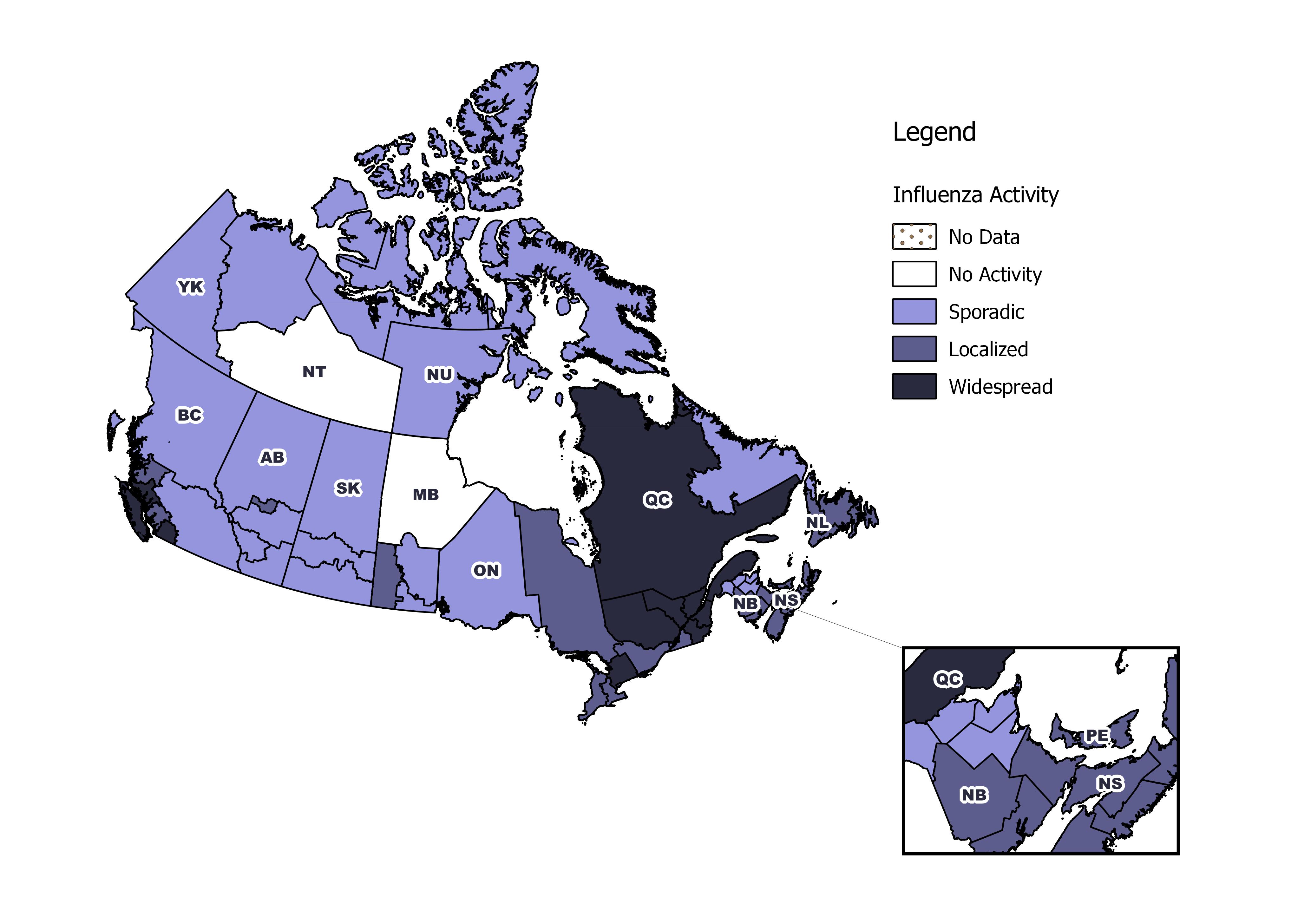
Note: Influenza/ILI activity levels, as represented on this map, are assigned and reported by Provincial and Territorial Ministries of Health, based on laboratory confirmations, sentinel ILI rates and reported outbreaks. Please refer to detailed definitions at the end of the report. Maps from previous weeks, including any retrospective updates, are available in the mapping feature found in the Weekly Influenza Reports.
Figure 1 - Text Description
| Influenza Surveillance Region | Activity Level |
|---|---|
| Newfoundland - Central | Localized |
| Newfoundland - Eastern | Localized |
| Grenfell Labrador | Sporadic |
| Newfoundland - Western | Localized |
| Prince Edward Island | Localized |
| Nova Scotia - Central (Zone 4) | Localized |
| Nova Scotia - Western (Zone 1) | Localized |
| Nova Scotia - Northern (Zone 2) | Localized |
| Nova Scotia - Eastern (Zone 3) | Localized |
| New Brunswick - Public Health Region 1 | Localized |
| New Brunswick - Public Health Region 2 | Localized |
| New Brunswick - Public Health Region 3 | Localized |
| New Brunswick - Public Health Region 4 | Sporadic |
| New Brunswick - Public Health Region 5 | Sporadic |
| New Brunswick - Public Health Region 6 | Sporadic |
| New Brunswick - Public Health Region 7 | Sporadic |
| Nord-est Québec | Widespread |
| Québec et Chaudieres-Appalaches | Widespread |
| Centre-du-Québec | Widespread |
| Montréal et Laval | Localized |
| Ouest-du-Québec | Widespread |
| Montérégie | Localized |
| Ontario - Central East | Widespread |
| Ontario - Central West | Localized |
| Ontario - Eastern | Localized |
| Ontario - North East | Localized |
| Ontario - North West | Sporadic |
| Ontario - South West | Localized |
| Ontario - Toronto | Localized |
| Manitoba - Interlake-Eastern | Sporadic |
| Manitoba - Northern Regional | No Activity |
| Manitoba - Prairie Mountain | Localized |
| Manitoba - South | Sporadic |
| Manitoba - Winnipeg | Localized |
| Saskatchewan - North | Sporadic |
| Saskatchewan - Central | Sporadic |
| Saskatchewan - South | Sporadic |
| Alberta - North Zone | Sporadic |
| Alberta - Edmonton | Localized |
| Alberta - Central Zone | Sporadic |
| Alberta - Calgary | Sporadic |
| Alberta - South Zone | Sporadic |
| British Columbia - Interior | Sporadic |
| British Columbia - Fraser | Widespread |
| British Columbia - Vancouver Coastal | Localized |
| British Columbia - Vancouver Island | Widespread |
| British Columbia - Northern | Sporadic |
| Yukon | Sporadic |
| Northwest Territories - North | Sporadic |
| Northwest Territories - South | No Activity |
| Nunavut - Baffin | Sporadic |
| Nunavut - Kivalliq | Sporadic |
| Nunavut - Kitimeot | Sporadic |
Laboratory-Confirmed Influenza Detections
In week 09, the overall percentage of tests positive for influenza was 30%. For the past two weeks, the percentage of tests positive for influenza B has decreased. This indicates that the peak for influenza B detections occurred in week 07. This also suggests that the peak for the influenza season occurred week 07.
The percentage of influenza A detections for week 09 are below average but remain within the expected range for this time of year. The percentage of tests positive for influenza B in week 09 continues to be well above expected levels for this time of year. For data on other respiratory virus detections, see the Respiratory Virus Detections in Canada Report.
Figure 2 - Number of positive influenza tests and percentage of tests positive, by type, subtype and report week, Canada, weeks 2017-35 to 2018-09
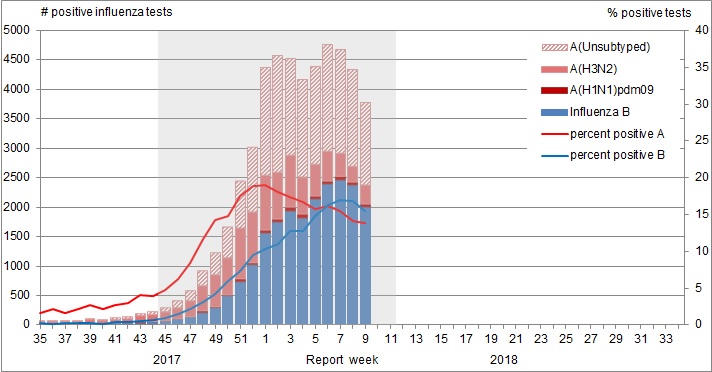
The shaded area indicates weeks where the positivity rate was at least 5% and a minimum of 15 positive tests were observed, signalling the period of seasonal influenza activity.
Figure 2 - Text Description
| Report Week | A(Unsubtyped) | A(H3) | A(H1)pdm09 | Influenza B |
|---|---|---|---|---|
| 35 | 3 | 20 | 6 | 5 |
| 36 | 7 | 28 | 1 | 3 |
| 37 | 7 | 14 | 13 | 4 |
| 38 | 18 | 31 | 3 | 5 |
| 39 | 18 | 53 | 1 | 8 |
| 40 | 24 | 41 | 1 | 5 |
| 41 | 32 | 50 | 0 | 11 |
| 42 | 27 | 73 | 1 | 15 |
| 43 | 44 | 107 | 3 | 21 |
| 44 | 52 | 114 | 3 | 30 |
| 45 | 71 | 153 | 7 | 47 |
| 46 | 113 | 187 | 13 | 75 |
| 47 | 157 | 272 | 13 | 112 |
| 48 | 259 | 417 | 33 | 190 |
| 49 | 370 | 544 | 16 | 274 |
| 50 | 523 | 633 | 16 | 473 |
| 51 | 800 | 864 | 51 | 719 |
| 52 | 1105 | 856 | 33 | 1008 |
| 1 | 1836 | 925 | 60 | 1539 |
| 2 | 1987 | 808 | 49 | 1730 |
| 3 | 1649 | 870 | 80 | 1912 |
| 4 | 1675 | 632 | 57 | 1802 |
| 5 | 1664 | 542 | 54 | 2125 |
| 6 | 1819 | 506 | 49 | 2383 |
| 7 | 1754 | 405 | 63 | 2443 |
| 8 | 1644 | 277 | 51 | 2354 |
| 9 | 1412 | 323 | 48 | 1991 |
To date this season, 50,912 laboratory-confirmed influenza detections have been reported, of which 58% have been influenza A. Influenza A(H3N2) has been the most common subtype detected this season, representing 93% of subtyped influenza A detections. For more detailed weekly and cumulative influenza data, see the text descriptions for Figures 2 and 3 or the Respiratory Virus Detections in Canada Report.
Figure 3 - Cumulative numbers of positive influenza specimens by type/subtype and province/territory, Canada, weeks 2017-35 to 2018-09

Figure 3 - Text Description
| Reporting provincesTable Figure 3 - Footnote 1 |
Week (February 25, 2018 to March 3, 2018) | Cumulative (August 27, 2017 to March 3, 2018) | |||||||||
|---|---|---|---|---|---|---|---|---|---|---|---|
| Influenza A | B | Influenza A | B | A & B Total |
|||||||
| A Total |
A (H1)pdm09 |
A (H3) |
A(UnS)Table Figure 3 - Footnote 3 | B Total |
A Total |
A (H1)pdm09 |
A (H3) |
A(UnS)Table Figure 3 - Footnote 3 | B Total |
||
| BC | 25 | 11 | 14 | 0 | 22 | 1968 | 339 | 1237 | 392 | 2337 | 4305 |
| AB | 463 | 13 | 318 | 132 | 122 | 5393 | 134 | 3915 | 1344 | 2749 | 8142 |
| SK | 27 | 0 | 8 | 19 | 80 | 1625 | 43 | 1109 | 473 | 1174 | 2799 |
| MB | 25 | 2 | 22 | 1 | 1 | 1097 | 7 | 365 | 725 | 353 | 1450 |
| ON | 44 | 4 | 27 | 13 | 20 | 4697 | 178 | 2646 | 1873 | 3732 | 8429 |
| QC | 80 | 0 | 0 | 80 | 22 | 12892 | 0 | 0 | 12892 | 9790 | 22682 |
| NB | 11 | 0 | 3 | 8 | 0 | 1029 | 6 | 186 | 837 | 608 | 1637 |
| NS | 2 | 0 | 0 | 2 | 0 | 349 | 0 | 0 | 349 | 150 | 499 |
| PE | 1 | 0 | 1 | 0 | 0 | 81 | 3 | 78 | 0 | 124 | 205 |
| NL | 0 | 0 | 0 | 0 | 0 | 233 | 0 | 3 | 230 | 225 | 458 |
| YT | 0 | 0 | 0 | 0 | 2 | 63 | 6 | 39 | 18 | 41 | 104 |
| NT | 0 | 0 | 0 | 0 | 0 | 128 | 4 | 124 | 0 | 29 | 157 |
| NU | 5 | 0 | 5 | 0 | 0 | 42 | 6 | 36 | 0 | 3 | 45 |
| Canada | 683 | 30 | 398 | 255 | 269 | 29597 | 726 | 9738 | 19133 | 21315 | 50912 |
| PercentageTable Figure 3 - Footnote 2 | 72% | 4% | 58% | 37% | 28% | 58% | 2% | 33% | 65% | 42% | 100% |
Discrepancies in values in Figures 2 and 3 may be attributable to differing data sources. Cumulative data includes updates to previous weeks. |
|||||||||||
To date this season, detailed information on age and type/subtype has been received for 41,767 laboratory-confirmed influenza cases (Table 1). Adults 65 years of age and older represent the largest proportion of cases overall (49%), and among cases of influenza A(H3N2) (58%) and influenza B (47%). Adults aged 20-64 represent 32% of cases overall and 30% of influenza A(H3N2) and 34% of influenza B cases. Although much smaller in numbers (596), the majority of influenza A(H1N1) cases are among adults less than 65 years of age, with adults aged 20-64 and children 0-19 years accounting for 54% and 32% of cases respectively.
| Age groups (years) | Cumulative (August 27, 2017 to March 3, 2018) | ||||||
|---|---|---|---|---|---|---|---|
| Influenza A | B | Influenza A and B | |||||
| A Total | A(H1) pdm09 | A(H3) | A (UnS)Table 1 Footnote 1 | Total | # | % | |
| 0-4 | 2569 | 106 | 507 | 1956 | 1159 | 3728 | 9% |
| 5-19 | 1971 | 87 | 499 | 1385 | 2135 | 4106 | 10% |
| 20-44 | 3610 | 170 | 1086 | 2354 | 2229 | 5839 | 14% |
| 45-64 | 3926 | 150 | 1286 | 2490 | 3596 | 7522 | 18% |
| 65+ | 12593 | 83 | 4615 | 7895 | 7979 | 20572 | 49% |
| Total | 24669 | 596 | 7993 | 16080 | 17098 | 41767 | 100% |
|
|||||||
Syndromic/Influenza-like Illness Surveillance
Healthcare Professionals Sentinel Syndromic Surveillance
In week 09, 3.2% of visits to healthcare professionals were due to influenza-like illness (ILI); similar to the previous week, and above the 5-year average.
Figure 4 - Percentage of visits for ILI reported by sentinels by report week, Canada, weeks 2017-35 to 2018-09
Number of Sentinels Reporting in Week 09: 177
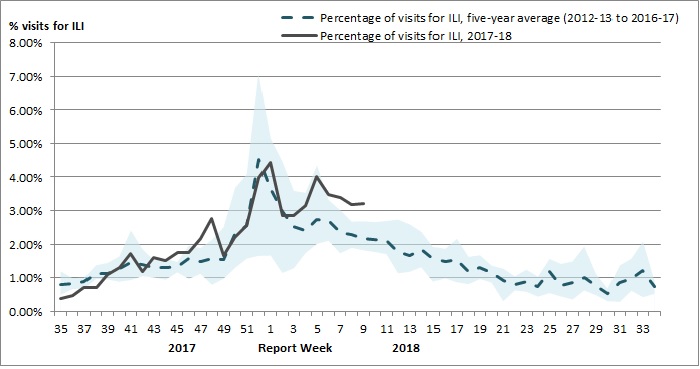
The shaded area represents the maximum and minimum percentage of visits for ILI reported by week from seasons 2012-13 to 2017-18
Figure 4 - Text Description
| Report week | 2017-18 | Average | Min | Max |
|---|---|---|---|---|
| 35 | 0.4% | 0.8% | 0.5% | 1.2% |
| 36 | 0.5% | 0.8% | 0.7% | 1.0% |
| 37 | 0.7% | 0.9% | 0.7% | 1.0% |
| 38 | 0.7% | 1.1% | 1.0% | 1.4% |
| 39 | 1.1% | 1.1% | 0.9% | 1.4% |
| 40 | 1.3% | 1.3% | 0.9% | 1.6% |
| 41 | 1.7% | 1.4% | 0.9% | 2.4% |
| 42 | 1.2% | 1.4% | 1.0% | 1.9% |
| 43 | 1.6% | 1.3% | 1.0% | 1.5% |
| 44 | 1.5% | 1.3% | 0.9% | 1.6% |
| 45 | 1.8% | 1.3% | 1.2% | 1.5% |
| 46 | 1.7% | 1.6% | 1.0% | 2.0% |
| 47 | 2.2% | 1.5% | 1.1% | 1.9% |
| 48 | 2.8% | 1.6% | 0.8% | 2.1% |
| 49 | 1.7% | 1.5% | 1.0% | 2.5% |
| 50 | 2.2% | 2.3% | 1.3% | 3.7% |
| 51 | 2.6% | 2.5% | 1.6% | 4.1% |
| 52 | 4.0% | 4.5% | 1.7% | 7.1% |
| 1 | 4.4% | 3.7% | 1.7% | 5.2% |
| 2 | 2.8% | 3.0% | 1.1% | 4.5% |
| 3 | 2.8% | 2.5% | 1.3% | 3.6% |
| 4 | 3.1% | 2.4% | 1.7% | 3.5% |
| 5 | 4.1% | 2.7% | 2.0% | 4.4% |
| 6 | 3.5% | 2.7% | 2.1% | 3.3% |
| 7 | 3.4% | 2.4% | 1.7% | 3.0% |
| 8 | 3.2% | 2.3% | 1.9% | 2.7% |
| 9 | 3.2% | 2.2% | 1.8% | 2.7% |
Participatory Syndromic Surveillance
FluWatchers is a participatory ILI surveillance system that relies on weekly voluntary submissions of syndromic information from Canadians across Canada.
In week 09, 1,419 participants reported to FluWatchers, of which 3% reported symptoms of cough and fever, and 14% of these consulted a healthcare professional. Among participants who reported cough and fever, 69% reported days missed from work or school, resulting in a combined total of 90 missed days of work or school.
| Number of Participants Reporting | Percentage participants reporting Cough and Fever | Percentage of participants with cough and fever who consulted a healthcare professional | Percentage of participants with cough and fever who reported missed days from work or school | Number of missed days from work or school |
|---|---|---|---|---|
| 1419 | 3% | 14% | 69% | 90 |
Influenza Outbreak Surveillance
In week 09, 103 laboratory-confirmed outbreaks of influenza were reported, an increase compared to the previous week. Among the reported influenza outbreaks, 79 were reported in long-term care facilities, eight in hospitals, and 16 in other settings. In addition, seven ILI outbreaks were reported schools. Among the 87 outbreaks with influenza type/subtype reported, 48 (55%) were associated with influenza B, 37 (43%) were associated with influenza A and two outbreaks were associated with a mix of influenza A and B (2%).
To date this season, 1,428 influenza/ILI outbreaks have been reported, of which 865 (61%) occurred in LTC facilities. Among the 1,232 outbreaks for which the influenza type/subtype was reported, 672 (54%) were associated with influenza A and 498 (40%) were associated with influenza B, and 62 (5%) were associated with a mix of A and B.
Figure 5 - Number of new outbreaks of laboratory-confirmed influenza by report week, Canada, weeks 2017-35 to 2018-09
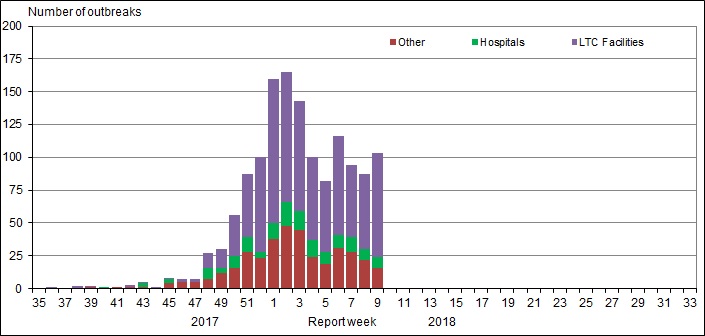
Figure 5 - Text Description
| Report week | Hospitals | Long Term Care Facilities | Other |
|---|---|---|---|
| 35 | 0 | 0 | 0 |
| 36 | 0 | 1 | 0 |
| 37 | 0 | 0 | 0 |
| 38 | 0 | 2 | 0 |
| 39 | 0 | 1 | 1 |
| 40 | 1 | 0 | 0 |
| 41 | 0 | 0 | 1 |
| 42 | 0 | 2 | 1 |
| 43 | 3 | 1 | 1 |
| 44 | 0 | 1 | 0 |
| 45 | 3 | 1 | 4 |
| 46 | 0 | 2 | 5 |
| 47 | 0 | 2 | 5 |
| 48 | 9 | 11 | 7 |
| 49 | 4 | 14 | 12 |
| 50 | 9 | 31 | 16 |
| 51 | 11 | 48 | 28 |
| 52 | 5 | 72 | 23 |
| 1 | 12 | 110 | 38 |
| 2 | 18 | 99 | 48 |
| 3 | 14 | 84 | 45 |
| 4 | 13 | 63 | 24 |
| 5 | 9 | 54 | 19 |
| 6 | 10 | 75 | 31 |
| 7 | 11 | 55 | 28 |
| 8 | 8 | 57 | 22 |
| 9 | 8 | 79 | 16 |
Severe Outcomes Influenza Surveillance
Provincial/Territorial Influenza Hospitalizations and Deaths
To date this season, 3,892 influenza-associated hospitalizations were reported by participating provinces and territories1. Among the hospitalizations, 2,861 (74%) were associated with influenza A, and 2,629 cases (68%) were in adults 65 years of age or older.
Additionally, 377 ICU admissions and 189 deaths have been reported to date. Adults aged 65 years of age or older accounted for the greatest proportion of ICU cases (43%), followed closely by adults aged 20-64 (42%). Adults aged 65 years of age or older accounted the majority of deaths (84%).
Figure 6 - Cumulative numbers of hospitalizations by age-group reported by participating provinces and territoriesfigure 6 note 1, weeks 2017-35 to 2018-09
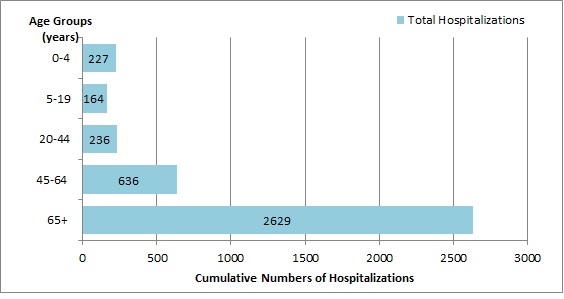
Figure 6 - Text Description
| Age Group | Total |
|---|---|
| 0-4 yr | 227 |
| 5-19 yr | 164 |
| 20-44 yr | 236 |
| 45-64 yr | 636 |
| 65+ yr | 2629 |
- Figure 6 note 1
-
Influenza-associated hospitalizations are reported by NL, PE, NS, NB, MB, AB, YT and NT. Only hospitalizations that require intensive medical care are reported by SK.
Pediatric Influenza Hospitalizations and Deaths
In week 09, the number of laboratory-confirmed influenza-associated pediatric (≤16 years of age) hospitalizations reported by the Immunization Monitoring Program Active (IMPACT) network decreased compared to the previous week. In week 09, 58 hospitalizations were reported of which 36 (62%) were due to influenza A. The number of weekly hospitalizations has been above the seven-season average since week 45.
To date this season, 811 pediatric hospitalizations have been reported by the IMPACT network, 516 (64%) of which were associated with influenza A. Children 0-23 months accounted for the largest proportion of influenza A hospitalizations (39%). Among the 295 hospitalizations due to influenza B, children 5-9 years accounted for the largest proportion of cases (30%).
Additionally, 135 ICU admissions and nine deaths have been reported to date. Children aged 0-23 months accounted for the greatest proportion of ICU cases (28%), followed closely by children aged 10-16 years (27%). Among the ICU cases with available information, 65% were due to influenza A and approximately 43% had no reported previous or concurrent medical conditions. All reported deaths were among children over the age of two.
Figure 7 - Cumulative numbers of pediatric hospitalizations (≤16 years of age) with influenza by type and age-group reported by the IMPACT network, Canada, weeks 2017-35 to 2018-09

Figure 7 - Text Description
| Age Group | Total |
|---|---|
| 0-5 mo | 90 |
| 6-23 mo | 184 |
| 2-4 yr | 214 |
| 5-9 yr | 182 |
| 10-16 yr | 141 |
Figure 8 - Number of pediatric hospitalizations (≤16 years of age) with influenza reported by the IMPACT network, by week, Canada, weeks 2017-35 to 2018-09
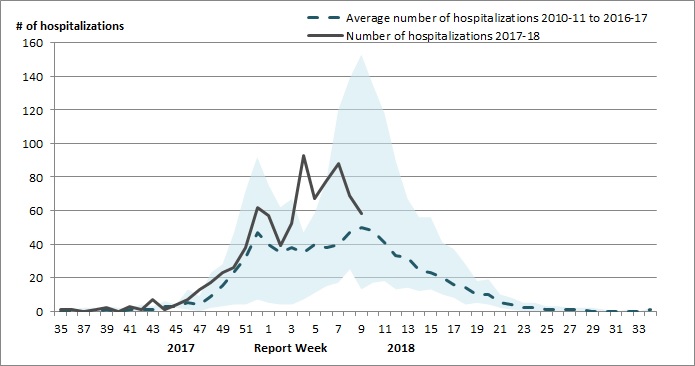
Figure 8 - Text Description
| Report Week | 2017-2018 | Average | Min | Max |
|---|---|---|---|---|
| 35 | 0 | 0 | 0 | 0 |
| 36 | 1 | 0 | 0 | 1 |
| 37 | 0 | 0 | 0 | 2 |
| 38 | 1 | 0 | 0 | 2 |
| 39 | 2 | 1 | 0 | 3 |
| 40 | 0 | 0 | 0 | 2 |
| 41 | 3 | 1 | 0 | 2 |
| 42 | 1 | 1 | 0 | 4 |
| 43 | 7 | 1 | 0 | 3 |
| 44 | 1 | 3 | 1 | 6 |
| 45 | 4 | 3 | 2 | 4 |
| 46 | 8 | 5 | 1 | 13 |
| 47 | 13 | 4 | 0 | 9 |
| 48 | 16 | 9 | 2 | 23 |
| 49 | 23 | 15 | 3 | 28 |
| 50 | 26 | 23 | 4 | 47 |
| 51 | 39 | 32 | 4 | 72 |
| 52 | 60 | 47 | 7 | 92 |
| 1 | 57 | 40 | 5 | 75 |
| 2 | 39 | 35 | 4 | 62 |
| 3 | 50 | 38 | 4 | 67 |
| 4 | 93 | 35 | 7 | 47 |
| 5 | 67 | 40 | 11 | 59 |
| 6 | 88 | 40 | 17 | 120 |
| 7 | 88 | 40 | 17 | 120 |
| 8 | 69 | 47 | 25 | 139 |
| 9 | 58 | 50 | 13 | 153 |
- Figure 8 Footnote 1
-
The shaded area represents the maximum and minimum number of cases reported by week from seasons 2010-11 to 2017-18
Influenza Strain Characterizations
During the 2017-18 influenza season, the National Microbiology Laboratory (NML) has characterized 2,085 influenza viruses [1,040 A(H3N2), 123 A(H1N1)pdm09 and 922 B viruses] that were received from Canadian laboratories.
Antigenic Characterization
Among influenza viruses characterized by hemagglutination inhibition assay during the 2017-18 season, most viruses were antigenically similar to the cell-culture propagated reference strains recommended by WHO.
| Strain Characterization Results | Count | Description |
|---|---|---|
| Influenza A (H3N2) | ||
| A/Hong Kong/4801/2014-like | 207 | Viruses antigenically similar to A/Hong Kong/4801/2014, the A(H3N2) component of the 2017-18 Northern Hemisphere's trivalent and quadrivalent vaccine. |
| Reduced titer to A/Hong Kong/4801/2014 | 30 | These A(H3N2) viruses reacted poorly with antisera raised against cell-propagated A/Hong Kong/4801/2014, suggesting some antigenic differences |
| Influenza A (H1N1)pdm09 | ||
| A/Michigan/45/2015-like | 123 | Viruses antigenically similar to A/Michigan/45/2015, the A(H1N1)pdm09 component of the 2017-18 Northern Hemisphere's trivalent and quadrivalent influenza vaccine. |
| Influenza B | ||
| B/Brisbane/60/2008-like (Victoria lineage) | 8 | Viruses antigenically similar to B/Brisbane/60/2008. B/Brisbane/60/2008 is the influenza B component of the 2017-18 Northern Hemisphere's trivalent and quadrivalent influenza vaccine. |
| Reduced titer to B/Brisbane/60/2008 (Victoria lineage) |
36 | These B/Victoria lineage viruses reacted poorly with antisera raised against cell-propagated B/Brisbane/60/2008, suggesting some antigenic differences. |
| B/Phuket/3073/2013-like (Yamagata lineage) |
878 | Viruses antigenically similar to B/Phuket/3073/2013, the additional influenza B component of the 2017-18 Northern Hemisphere quadrivalent influenza vaccine. |
Genetic Characterization of A(H3N2) viruses
During the 2017-18 season, 803 A(H3N2) viruses did not grow to sufficient titers for antigenic characterization by HI assay. Therefore, genetic characterization was performed to determine to which genetic group they belong. Sequence analysis showed that 719 A(H3N2) viruses belonged to genetic group 3C.2a, 82 viruses belonged to subclade 3C.2a1 and two viruses belonged to the clade 3C.3a.
Additionally, of the 237 influenza A(H3N2) viruses that were characterized antigenically as similar to A/Hong Kong/4801/2014, 176 belonged to genetic group 3C.2a and 21 viruses belonged to subclade 3C.2a1. The 30 viruses that showed reduced titer to A/Hong Kong/4801/2014 belonged to genetic clade 3C.3a. Sequencing is pending for the 10 remaining virus isolates.
A/Hong Kong/4801/2014-like virus belongs to genetic group 3C.2a and is the influenza A/H3N2 component of the 2017-18 Northern Hemisphere influenza vaccine.
Genetic Characterization of Influenza B viruses
Among the viruses characterized antigenically as having reduced titer to ferret antisera produced against cell-propagated B/Brisbane/60/2008, sequence analysis showed that 28 viruses had a two amino acid deletion in the HA gene. Sequencing is pending for the eight remaining virus isolates.
Antiviral Resistance
During the 2017-18 season, the National Microbiology Laboratory (NML) has tested 913 influenza viruses for resistance to oseltamivir and 909 viruses for resistance to zanamivir. All but one of the A(H1N1) viruses were sensitive to oseltamivir and all but one influenza B viruses were sensitive to zanamivir (Table 4).
| Virus type and subtype | Oseltamivir | Zanamivir | ||
|---|---|---|---|---|
| # tested | # resistant (%) | # tested | # resistant (%) | |
| A (H3N2) | 435 | 0 (0%) | 431 | 0 (0%) |
| A (H1N1) | 89 | 1 (1.1%) | 89 | 0 (0%) |
| B | 389 | 0 (0%) | 389 | 1 (0.3%) |
| TOTAL | 913 | 1 (0.1%) | 909 | 1 (0.1%) |
Note: Since the 2009 pandemic, all circulating influenza A viruses have been resistant to amantadine, and it is therefore not currently recommended for use in the treatment of influenza. During the 2017-18 season, the subset of influenza A viruses that were tested for resistance to amantadine were resistant. |
||||
Provincial and International Influenza Reports
Provincial Influenza Reports
- Alberta - Influenza Surveillance Report
- British Columbia - Influenza Surveillance
- Manitoba - Seasonal Influenza Reports
- New Brunswick - Influenza Surveillance Reports
- Newfoundland and Labrador - Surveillance and Disease Reports
- Nova Scotia - Respiratory Watch Report
- Ontario - Respiratory Pathogen Bulletin
- Prince Edward Island - Influenza Summary
- Saskatchewan - Influenza Reports
- Québec - Flash Grippe
International Influenza Reports
- Australia - Influenza Surveillance Report
- European Centre for Disease Prevention and Control - Surveillance reports and disease data on seasonal influenza
- New Zealand - Influenza Weekly Update
- Public Health England - Weekly national flu reports
- Pan-American Health Organization - Influenza Situation Report
- United States Centres for Disease Control and Prevention - Weekly Influenza Surveillance Report
- World Health Organization - Influenza update
- World Health Organization - FluNet
FluWatch Surveillance System Description and Definitions, 2017-18
The FluWatch report is compiled from a number of data sources. Surveillance information contained in this report is a reflection of the surveillance data available to FluWatch at the time of production. Delays in reporting of data may cause data to change retrospectively. For a description of FluWatch surveillance components and definitions, see System Description and Definitions.
Abbreviations: Newfoundland/Labrador (NL), Prince Edward Island (PE), New Brunswick (NB), Nova Scotia (NS), Quebec (QC), Ontario (ON), Manitoba (MB), Saskatchewan (SK), Alberta (AB), British Columbia (BC), Yukon (YT), Northwest Territories (NT), Nunavut (NU).
We would like to thank all the FluWatch surveillance partners who are participating in this year's influenza surveillance program.